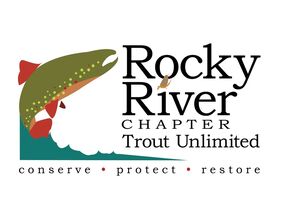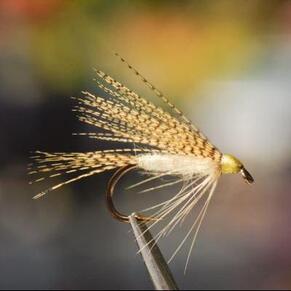Fly of the Month 04.12 Light Cahill Wet
This “fly of the month” represents the latest in the Tim Wilhelm/Tom Adams series.
Except for the occasional soft hackle, I don’t fish wet flies. I prefer fishing dry flies and will resort to dragging something across the bottom when the fish aren’t looking up. So when Tom suggested the Light Cahill wet for this month’s fly, I thought this might be a good opportunity. I like fishing on the surface with dry flies as much as I can and if I have to I’ll go deep with nymphs (and those other things like eggs and San Juan worms). I don’t fish that water in between and I should.
It is critical fishing either a dry fly or a nymph that there is no drag but not so for a wet fly. With a wet you fish downstream by casting across and as the fly reaches the end of its drift the line straightens and the fly “hatches”. There is no worry about drag, and the fly has a little action to it. Cast your wet across the stream and slightly down stream. Mend the line upstream as needed so the fly will be traveling parallel with the bank. Hopefully everything will work out and your fly will go by the nose of the fish just as the line starts to straighten out. Hold on!
- Tim
Fly of the Month 04.12 Light Cahill Wet
Hook: Tiemco 100 or equivalent, Size : 12, 14, 16, 18
Thread: Uni 8/0 or equivalent in Light Cahill
Tail: Lemon Wood Duck Flank Feathers or substitute
Abdomen/Thorax: Light Cahill dubbing
Legs: Cream soft hackle
Wing: Lemon Wood Duck Flank Feathers or substitute
The photo shown is tied on a Mustad “antique” 94840 Viking hook. These were purchased through an online auction. The current profile is somewhat more elongated and just as effective.
Directions:
1) Secure hook in vise and wrap thread in tight wraps starting two eye lengths from the eye and stopping just before the hook bend. Select ten or so wood duck feathers and make sure the tips are even and tie in on top of the hook shank. Wrap forward two thirds of the shank keeping the feathers on top. Trim excess feathers and return the bobbin using tights wraps to the tail tie in point. Let the bobbin hang.
Note: I keep the waste from any use of Lemon Wood duck. There are normally several dozen fibers left after use on the first tie; these are perfectly fine for using as a tailing or wing case. This is appropriate for several different flies. I only throw away the fuzzy scraps !
2) Using Light Cahill dubbing form a tapered dub rope and wind forward in butting wraps to form a carrot shaped body. Wrap to within about four eye lengths from the hook eye. Let the bobbin hang.
3) Select a cream color soft hackle feather, and tie in close to where the dubbing stops, by the tip. Before tying the feather, grab the tip end of the feather with tweezers and gently stroke the barbs back. This will cause the barbs to separate and stand out at 90 degrees from the feather shaft. You will also be able to determine if the length of the barbs are correct. When tied in, they should not be longer than the hook shank. After securing the feather tip with several wraps of thread let the bobbin hang and trim the excess tip. Using hackle pliers, grab the fuzzy end of the hackle feather and after checking to make sure the “shiny” side is toward the hook and make two, full wraps tight to each other, stroking back the barbs as you wind. Take the thread through the barbs and tie down with two wraps. Trim the excess feather close to the tie in and secure with three more wraps. Let the bobbin hang.
4) Select a Lemon Wood Duck Flank feather andstroke back the uneven barbs. The end of the feather should be somewhat square. It is not as necessary to be extremely precise like when you are tying a divided wing on a dry fly, but the more uniform the barbs are in length the happier you will be. Tie in the feather on top of the hook, secure with several wraps, trim the excess and form and nice head. Do not crowd the hook eye. Apply head cement to from a handsome head and you are done.
- Tom Adams, Tim Wilhelm
This “fly of the month” represents the latest in the Tim Wilhelm/Tom Adams series.
Except for the occasional soft hackle, I don’t fish wet flies. I prefer fishing dry flies and will resort to dragging something across the bottom when the fish aren’t looking up. So when Tom suggested the Light Cahill wet for this month’s fly, I thought this might be a good opportunity. I like fishing on the surface with dry flies as much as I can and if I have to I’ll go deep with nymphs (and those other things like eggs and San Juan worms). I don’t fish that water in between and I should.
It is critical fishing either a dry fly or a nymph that there is no drag but not so for a wet fly. With a wet you fish downstream by casting across and as the fly reaches the end of its drift the line straightens and the fly “hatches”. There is no worry about drag, and the fly has a little action to it. Cast your wet across the stream and slightly down stream. Mend the line upstream as needed so the fly will be traveling parallel with the bank. Hopefully everything will work out and your fly will go by the nose of the fish just as the line starts to straighten out. Hold on!
- Tim
Fly of the Month 04.12 Light Cahill Wet
Hook: Tiemco 100 or equivalent, Size : 12, 14, 16, 18
Thread: Uni 8/0 or equivalent in Light Cahill
Tail: Lemon Wood Duck Flank Feathers or substitute
Abdomen/Thorax: Light Cahill dubbing
Legs: Cream soft hackle
Wing: Lemon Wood Duck Flank Feathers or substitute
The photo shown is tied on a Mustad “antique” 94840 Viking hook. These were purchased through an online auction. The current profile is somewhat more elongated and just as effective.
Directions:
1) Secure hook in vise and wrap thread in tight wraps starting two eye lengths from the eye and stopping just before the hook bend. Select ten or so wood duck feathers and make sure the tips are even and tie in on top of the hook shank. Wrap forward two thirds of the shank keeping the feathers on top. Trim excess feathers and return the bobbin using tights wraps to the tail tie in point. Let the bobbin hang.
Note: I keep the waste from any use of Lemon Wood duck. There are normally several dozen fibers left after use on the first tie; these are perfectly fine for using as a tailing or wing case. This is appropriate for several different flies. I only throw away the fuzzy scraps !
2) Using Light Cahill dubbing form a tapered dub rope and wind forward in butting wraps to form a carrot shaped body. Wrap to within about four eye lengths from the hook eye. Let the bobbin hang.
3) Select a cream color soft hackle feather, and tie in close to where the dubbing stops, by the tip. Before tying the feather, grab the tip end of the feather with tweezers and gently stroke the barbs back. This will cause the barbs to separate and stand out at 90 degrees from the feather shaft. You will also be able to determine if the length of the barbs are correct. When tied in, they should not be longer than the hook shank. After securing the feather tip with several wraps of thread let the bobbin hang and trim the excess tip. Using hackle pliers, grab the fuzzy end of the hackle feather and after checking to make sure the “shiny” side is toward the hook and make two, full wraps tight to each other, stroking back the barbs as you wind. Take the thread through the barbs and tie down with two wraps. Trim the excess feather close to the tie in and secure with three more wraps. Let the bobbin hang.
4) Select a Lemon Wood Duck Flank feather andstroke back the uneven barbs. The end of the feather should be somewhat square. It is not as necessary to be extremely precise like when you are tying a divided wing on a dry fly, but the more uniform the barbs are in length the happier you will be. Tie in the feather on top of the hook, secure with several wraps, trim the excess and form and nice head. Do not crowd the hook eye. Apply head cement to from a handsome head and you are done.
- Tom Adams, Tim Wilhelm

